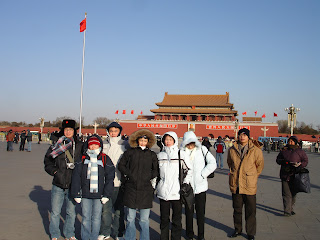Beijing is the capital of China. In December 2006, my family and I had the opportunity to spend some time in this wonderful and historical city.
The rich history of Beijing dates as far back as 3000 years ago. Beijing didn't actually become the capital of China until Kublai Khan made Dadu (a former name for Beijing) the capital during the Yuan Dynasty (1279-1368).
 |
| Photo by a girl |
In 2008, Beijing was given the opportunity to hold the summer Olympics and show the world what a wonderful city it is. Bird's Nest also known as Beijing National Stadium was designed and built for use throughout the 2008 Summer Olympics and Paralympics.
 | ||||||||
| Photo by .curt. |
Even though Beijing is located in the northern part of China it rarely snows during winter. They may get one to two snow day a year. Weather they usually get is a dry, cold, and bone chilling wind. Don't get me wrong; even without the snow their weather is comparable to our -30 degrees.
 |
| Tiananmen Square Photo by: Lily Ha |
First stop of our trip was Tiananmen Square. This is located in the
heart of Beijing. Thousands of people come to this square every day. Here you can also visit Tiananmen Tower which is the
gate tower to the Forbidden City, Monument to People's Heroes, the Great
Hall of the People, National Museum of China, and the Mausolum of Mao Zedong.
Even though we were there in the middle of December during winter, there were still a lot of people walking around checking out the historical attractions. You can tell how cold the weather really is by noticing that everyone is bundled up and trying to stay warm.
 |
| Tiananmen gate tower to the Forbidden City Photo by: Lily Ha |
 |
| Monument to the People's Heroes Photo by: Lily Ha |
 |
| National Museum of China Photo by: Lily Ha |
 |
| The Great Hall of the People Photo by: Lily Ha |
From here we ventured off to check out the Forbidden City. After entering the gate the first thing we noticed was the Hall of Supreme Harmony. It's really magnificent and incredible the amount of detail there is on the stone stairway leading into the hall. All the carvings done on the stairway was done by hand. Over the years the stairways have been blocked off to reduce further wear and tear by the amount of people that comes to see this monument.
 |
| Photo by: Lily Ha |
 |
| Photo by: Lily Ha |
 |
| Photo by: Lily Ha |
The Imperial Palace was home to 24 emperors during the Ming (1368-1644) and Qing (1644-1911) dynasties. The size and detail of this place is was pretty unbelievable and this was all done before there were things like modern technology. A lot of the areas were closed off so we couldn't see the whole palace but the areas that were open for viewing was breath taking. The statues and art works that are on display are hard to believe from thousands of years ago.
 |
| Photo by: Lily Ha |
Next we continued to the Temple of Heaven. This is where the emperors visited for annual ceremonies of prayer to the Heaven for good harvest.
 |
| Photo by: Lily Ha |
 |
| Photo by: Lily Ha |
Last stop of our day was to the Thirteen Ming Tombs. The Imperial Ming Mausoleum was declared by the Beijing municipal government as one of the first Key Protected Ancient Cultural Sites in Beijing.
 |
| Photo by: Lily Ha |
Even though there are 13 emperors buried in this mausoleum only a couple of them are opened to the public because of various reasons. The one that we visited belonged to the 13th emperor Zhu Yijun and his two empresses. There was numerous of stuff buried with the emperor. The government unearth things such as the posthumous seal of the emperor, jewellery that belonged to the empresses, potteries used by the emperor, gold and silver ingot used during that time and much more. All of the stuff listed above is now on display in a hall after checking out the tomb.
After all the walking at some of the must see sites in Beijing it was time to head back to the hotel for a massage and nice foot rub. The price you pay for the service you get is unbeatable in Asia. :)
No comments:
Post a Comment